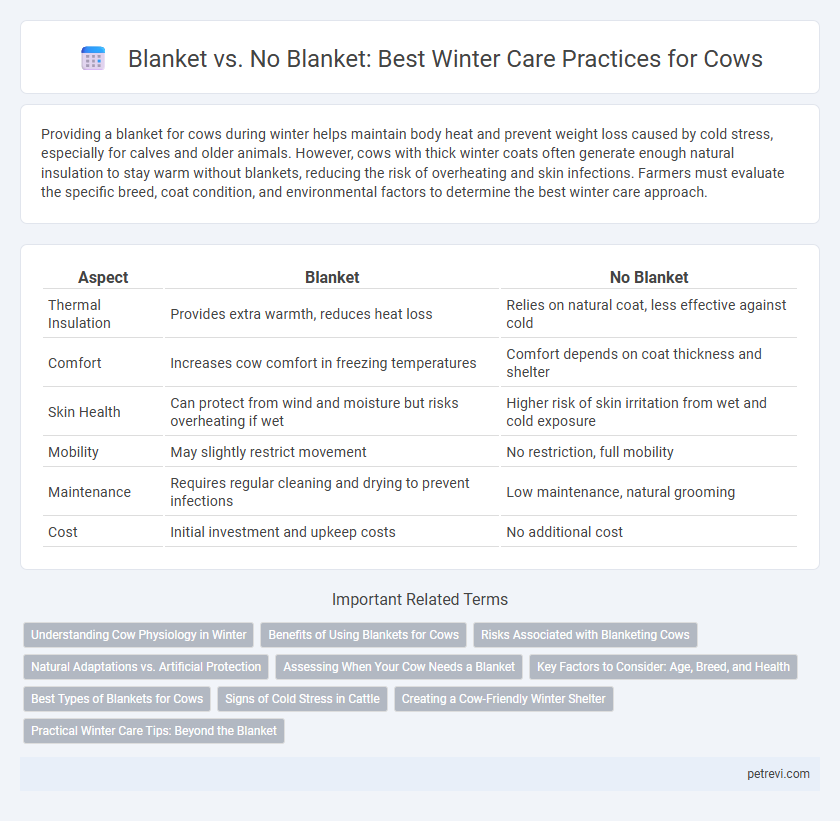Providing a blanket for cows during winter helps maintain body heat and prevent weight loss caused by cold stress, especially for calves and older animals. However, cows with thick winter coats often generate enough natural insulation to stay warm without blankets, reducing the risk of overheating and skin infections. Farmers must evaluate the specific breed, coat condition, and environmental factors to determine the best winter care approach.
Table of Comparison
| Aspect | Blanket | No Blanket |
|---|---|---|
| Thermal Insulation | Provides extra warmth, reduces heat loss | Relies on natural coat, less effective against cold |
| Comfort | Increases cow comfort in freezing temperatures | Comfort depends on coat thickness and shelter |
| Skin Health | Can protect from wind and moisture but risks overheating if wet | Higher risk of skin irritation from wet and cold exposure |
| Mobility | May slightly restrict movement | No restriction, full mobility |
| Maintenance | Requires regular cleaning and drying to prevent infections | Low maintenance, natural grooming |
| Cost | Initial investment and upkeep costs | No additional cost |
Understanding Cow Physiology in Winter
Cow winter care hinges on understanding bovine thermoregulation, where their thick winter coat naturally insulates against cold temperatures. Using a blanket may interfere with this natural adaptation by trapping moisture and limiting airflow, potentially increasing the risk of frostbite or skin infections. Proper shelter and nutrition optimize a cow's physical resilience, often making blankets unnecessary for healthy adult cattle in typical winter conditions.
Benefits of Using Blankets for Cows
Using blankets for cows during winter helps maintain body heat and prevents weight loss caused by cold stress. Insulated blankets reduce energy expenditure required for thermoregulation, promoting better milk production and overall health. Protecting cows with blankets also minimizes the risk of illness related to prolonged exposure to harsh weather conditions.
Risks Associated with Blanketing Cows
Blanketing cows during winter can lead to overheating and increased moisture retention, which may cause skin infections, fungal diseases, and discomfort. The added weight and restriction can stress animals, reducing natural insulation efficiency and potentially impacting mobility. Inadequate drying and ventilation under blankets elevate the risk of respiratory issues and parasite infestations, compromising overall herd health.
Natural Adaptations vs. Artificial Protection
Cows possess natural adaptations such as thick winter coats and a layer of subcutaneous fat to maintain body heat during cold weather, reducing the need for artificial protection. However, in extremely harsh climates or for vulnerable groups like calves or older cows, blankets can provide supplemental warmth and prevent cold stress. Effective winter care balances leveraging these natural defenses with targeted use of blankets to enhance animal welfare and productivity.
Assessing When Your Cow Needs a Blanket
A cow's need for a blanket during winter depends on factors such as breed, health, age, and environmental conditions like wind chill and precipitation. Thick-coated, healthy adult cows typically tolerate cold temperatures better than young, elderly, or sick animals, which may benefit from additional warmth. Regularly assessing body condition, behavior, and shelter availability helps determine if a blanket is necessary to prevent hypothermia and maintain optimal cow comfort.
Key Factors to Consider: Age, Breed, and Health
Blanket use for cows in winter depends heavily on age, breed, and health status; younger calves and older cows with thinner coats may benefit significantly from insulation to prevent hypothermia. Breeds with dense, long hair like Highland cattle often tolerate cold better without blankets, whereas short-haired or exotic breeds require additional protection. Health conditions such as weakened immunity or poor body condition increase vulnerability to cold stress, making blankets a vital factor in maintaining wellbeing.
Best Types of Blankets for Cows
Selecting the best types of blankets for cows during winter involves considering materials like waterproof breathable fabrics and insulation layers that retain heat without causing overheating. Heavyweight turnout blankets designed for livestock offer durability and protection against harsh weather, while fleece-lined options provide added warmth for older or weakened cows. Properly fitted blankets help maintain body temperature, reduce energy expenditure, and improve overall health and productivity throughout the cold season.
Signs of Cold Stress in Cattle
Signs of cold stress in cattle include shivering, reduced feed intake, and lowered milk production, indicating the animal's struggle to maintain body temperature. Providing a blanket can help maintain thermal comfort by reducing heat loss through the skin, especially in extreme winter conditions. Without adequate protection, cattle are more susceptible to hypothermia, decreased immune function, and slower growth rates during cold weather.
Creating a Cow-Friendly Winter Shelter
Providing a well-insulated cow-friendly winter shelter significantly reduces the need for blankets by offering protection against wind, moisture, and cold temperatures. Proper ventilation alongside dry bedding materials such as straw or sawdust helps maintain the cow's body heat naturally. Choosing shelter designs that prevent drafts and allow sunlight penetration ensures cows stay warm and comfortable throughout winter.
Practical Winter Care Tips: Beyond the Blanket
Providing adequate shelter and windbreaks is essential for cow winter care, as exposure to harsh winds and moisture can lead to stress and health issues regardless of blanket use. Ensuring dry bedding and proper nutrition with increased energy-rich feed supports natural thermoregulation and maintains body condition. Regular health monitoring and adjusting care strategies based on weather conditions offer practical benefits beyond relying solely on blankets.
Blanket vs No Blanket for Cow Winter Care Infographic

 petrevi.com
petrevi.com